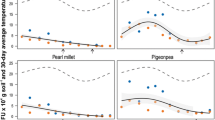Abstract
Rough lemon seedlings were root dip-inoculated in Fries liquid cultures of two Fusarium solani isolates, one from California and one from Florida. Plants were potted and placed in soil temperature tanks at 15, 21, 27, and 33 C. Plant height, trunk diameter, and fresh weight of inoculated plants significantly differed from the control at 15 and 21 C. Plant height was the only growth parameter significantly affected by inoculation at 27 and 33 C. Height of plants inoculated with the California isolate was significantly less than the control at 27 but not at 33 C. Height of plants inoculated with the Florida isolate did not differ from the controls at 27 and 33 C. Significantly more root rot occurred on inoculated plants at 15 and 21 C, but not at 27 and 33 C.
Similar content being viewed by others
References
Abdel-Raheem, A. & Bird, L. S., 1968. The interrelationship of resistance and susceptibility of cotton to Verticillium alboatrum and Fusarium oxysporum f. sp. vasinfectum as influenced by soil temperature. Phytopathology 58: 725. (Abstr.).
Allen, R. M. & Gardner, B. R., 1965. Dry root rot of citrus induced by ammonia excesses. 8th Annual Report on Soil Fertility and Fertilizer Research. University Arizona pp. 52–55.
Bhatnagar, G. C. & Prasad, N., 1966. Studies of Fusarium twig disease of lime (Citrus aurantifolia Swingle). Indian Phytopathology 19: 257–261.
Burke, D. W., Miller, D. E. & Barker, A. W., 1980. Effects of soil temperature on growth of beans in relation to soil compaction and Fusarium root rot. Phytopathology 70: 1047–1049.
Cheng, Y. H. & Schenck, N. C., 1978. Effect of soil temperature and moisture on survival of the soybean root rot fungi Neocosmospora vasinfecta and Fusarium solani in soil. Plant Disease Reporter 62: 945–949.
Komada, H., 1975. Development of a selective medium for quantitative isolation of Fusarium oxysporum from natural soil. Review of Plant Protection Research 8: 114–125.
Kraft, J. M. & Roberts, D. D., 1969. Influence of soil, water, and temperature on the pea root rot complex caused by Pythium ultimum and Fusarium solani f. sp. pisi. Phytopathology 59: 149–152.
Martin, J. P., 1949. Effect of soil fungi on germination of sweet orange seeds and development of the young seedlings. Soil Science Society of America Proceedings 14: 184–188.
Menge, J. A., Johnson, E. L. V., Sibert, D. & Burns, R. M., 1981. Dry root rot of citrus — a disease complex. Phytopathology 71: 242. (Abstr.).
Nemec, S. & Chaddock, A., 1977. Fusarium populations in Florida citrus soils. Phytopathology 4: 116–117. (Abstr.).
Nemec, S., Baker, R. & Burnett, H., 1980. Pathogenicity of Fusarium solani to citrus roots and its possible role in blight etiology. Proceedings Florida State Horticultural Society 93: 36–41.
O'Bannon, J. H., Leathers, C. R. & Reynolds, H. W., 1967. Interactions of Tylenchulus semipenetrans and Fusarium species on rough lemon (C. limon). Phytopathology 57: 414–417.
Ribeiro, Raul de L. D. & Hagedorn, D. J., 1977. The effects of incubation temperatures and inoculum levels on reaction of beans to Fusarium oxysporum f. sp. phaseoli. Proceedings American Phytopathological Society 4: 152–153. (Abstr.).
Sadaswan, T. S., 1961. Physiology of wilt disease. Annual Review of Plant Physiology 12, 449–468.
Sewell, G. W. F., 1965. The effect of altered physical condition of soil on biological control. Pages 479–494, In Ecology of Soilborne Plant Pathogens, K. F. Bakerand W. C. Snyder (eds.), University of California Press, Berkeley.
Sherbakoff, C. D., 1953. Fusaria associated with citrus feeder roots in Florida. Phytopathology 43: 395–397.
Warren, H. L. & Kommedahl, T., 1973. Prevalence and pathogenicity to corn of Fusarium species from corn roots, rhizospheres, residues and soil. Phytopathology 63: 1288–1290.
Van Gundy, S. D. & Tsao, P. H., 1963. Growth reduction of citrus seedlings by Fusarium solani as influenced by the citrus nematode and other soil factors. Phytopathology 53: 488–489.
Author information
Authors and Affiliations
Additional information
Formerly at the University of Florida, IFAS, Agricultural Research and Education Center, P.O. Box 1088, Lake Alfred, FL 33850, USA
Rights and permissions
About this article
Cite this article
Nemec, S., Zablotowicz, R.M. Effect of soil temperature on root rot of rough lemon caused by Fusarium solani. Mycopathologia 76, 185–190 (1981). https://doi.org/10.1007/BF00437199
Issue Date:
DOI: https://doi.org/10.1007/BF00437199




